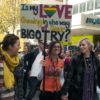In September 2018, Dr. Christine Blasey Ford testified before the US Senate judiciary committee about a sexual assault she alleged had occurred during high school at the hands of Brett Kavanaugh, a judge who was in the process of being confirmed to the US Supreme Court. Both Ford’s testimony and Kavanaugh’s defense of the allegations highlighted the vastly different and often gendered ways in which unwanted and nonconsensual sexual behaviors are defined, dismissed, and defended. For instance, while many women believed Ford and could relate to her high school experience, most men were somewhat ambivalent or even skeptical of her account. Even as many people believed something had happened to Ford during high school, they also tended to question the harms of an event that occurred so long ago at a high school party. Meanwhile, many questioned why Ford had not spoken out at the time of the event, challenging the accuracy of her recall and overall credibility. At the same time, Kavanaugh’s supporters expressed outrage at the attack on his credibility, and pointed to his lack of recall as proof that the incident had never happened. Social media commentary further illustrated the unease that many in our society feel about holding men accountable for behavior that they see as natural, normal (just “boys being boys”), or at least excusable due to the immaturity of youth. The fact that Kavanaugh was nonetheless confirmed to the Supreme Court also suggests the persuasion of such gendered accounts.
The power of gendered accounts
Gendered accounts are the rhetorical means by which people frame and defend inappropriate social behavior, including sexual violence, as more appropriate and acceptable. Accounts are both durable and effective because they draw upon stereotypes and assumptions that are deeply entrenched within the belief systems of the people who invoke or honor them. When applied to sexual victimization, accounts reinterpret predatory sexual behavior as something more ambiguous, benign, or at least not bad enough to ruin a man’s life. Worse, accounts shift blame from the accused to an accuser by questioning their motives or suggesting that victims themselves did something inappropriate (e.g., dressing provocatively, getting drunk, leading someone on). As such, accounts are a significant part of defense strategies in rape trials used to cast reasonable doubt. They are also part of everyday conversations used to defend identity and social reputations whenever challenged.
“Self-blame, embarrassment, and shame are common emotions experienced by victims, as well as barriers that prevent them from reporting to police, or even sharing their experiences with their closest friends.”I began looking at gendered accounts as a sociology graduate student in the early 2000s. My dissertation research, funded by the Sexuality Research Fellowship Program (SRFP) in 2005 and published in several journal articles,1→Karen G. Weiss, “‘Boys Will be Boys’ and Other Gendered Accounts: An Exploration of Victim Excuses and Justifications for Unwanted Sexual Contact and Coercion,” Violence Against Women 15, no. 7 (2009): 810–834.
→Karen G. Weiss, “Too Ashamed to Report: Deconstructing the Shame of Sexual Victimization,” Feminist Criminology 5, no. 3 (2010): 286–310.
→Karen G. Weiss, “Male Sexual Victimization: Examining Men’s Experiences of Rape and Sexual Assault,” Men and Masculinities 12, no. 3 (2010): 275–298.
→Karen G. Weiss, “Neutralizing Sexual Victimization: A Typology of Victims’ Non-Reporting Accounts,” Theoretical Criminology 15, no. 4 (2011): 445–467.
→Karen G. Weiss, “‘You Just Don’t Report That Kind of Stuff’: Investigating Teens’ Ambivalence Towards Unwanted Sexual Incidents,” Violence and Victims 28, no. 2 (2013): 288–302. examined the ways in which victims themselves—both women and men—use gendered accounts to define their unwanted sexual experiences. I found that victims often use accounts that deny the seriousness of their harms as coping mechanisms to help them make sense of traumatic experiences. I also found that many victims tended to blame themselves for what happened, which not only let offenders off the hook but impeded their recovery process.2For example, see Weiss, “‘Boys will be Boys’ and Other Gendered Accounts,” and Weiss, “Neutralizing Sexual Victimization.” Indeed, self-blame, embarrassment, and shame are common emotions experienced by victims, as well as barriers that prevent them from reporting to police, or even sharing their experiences with their closest friends. Reluctance to disclose sexual victimization is particularly common when offenders are part of a victim’s own peer group. In these cases, victims may remain silent in order to avoid appearing disloyal to their group, in addition to avoiding stigma and negative attention from their peers.3See also Karen G. Weiss, Party School: Crime, Campus and Community (Northeastern University Press, 2013).
Understanding the underlying accounts that support nondisclosure is important for breaking the silence that so often surrounds sexual crimes. When victims question the seriousness of their experiences, their own credibility, or whether they will be believed by police or other persons to whom they disclose, they are more likely to remain silent. Silence, shame, and secrecy, along with the assertion that some unwanted sexual behavior is normal, help perpetuate these crimes and explain their persistence.
Challenging the sexual violence status quo
Thus, empowering victims to feel emboldened to speak out is a necessary step toward crime reduction, social change, and a core objective of the #MeToo campaign that gained national attention in late 2017. Along with other social media campaigns such as “Time’s Up” that focuses on equity within the workplace, the #MeToo hashtag has inspired myriad women and men to share their experiences of sexual victimization online in recent years. At the same time, more women appear to be reporting rape and sexual assault to police. A recent report by the Bureau of Justice Statistics using National Crime Victimization Survey data shows that sexual crime reporting rose from 23 percent in 2016 to 40 percent in 2017,4Rachel E. Morgan and Jennifer L. Truman, Criminal Victimization, 2017 (Washington, DC: US Department of Justice, 2018). suggesting that victims are feeling emboldened to not just speak out but to seek justice.
Still, as important as it is for victims to be heard, disclosure is only the first step toward social change. Change also requires that our justice system and other social institutions take victims’ complaints seriously, including taking the appropriate steps to investigate and hold offenders accountable when warranted. Social change also requires cooperation from all other third parties with knowledge of such crime. Third parties are important as eyewitnesses after a crime to help police, and as deterrents to prevent crime in the first place. They are also the persons to whom victims often look when making determinations about disclosure. In fact, the responses and reactions of third parties may significantly impact how victims define their own experiences.5Karen G. Weiss and Lisa M. Dilks, “Intoxication and Crime Risks: Decontextualizing the Effects of ‘Party’ Routines on Physical and Sexual Attacks among College Students,” in “Crime in the Ivory Tower: Understanding Campus Victimization and Evaluating Efforts to Prevent It,” ed. Christina Mancini, special issue, Criminal Justice Review 41, no. 2 (2016): 173–189. Given the importance of third parties, rape prevention programs at many universities and colleges now promote bystander intervention to bolster third-party willingness to help someone in trouble.
“In a recent study of college crime, I found that a third of college students who witnessed sexual harassment (including verbal threats and unwanted sexual touching) utilized accounts to justify why they did not help.”Many researchers, including myself, have also begun to focus attention on the important roles of bystanders as “capable guardians” who can help reduce crime victimization.6See, for example, Nicola Henry and Anastasia Powell, eds., Preventing Sexual Violence: Interdisciplinary Approaches to Overcoming a Rape Culture (Palgrave MacMillan, 2014). My current research agenda includes looking at the impact of gendered accounts on witness responses to crime, and identifying the accounts that witnesses use to justify nonintervention. For instance, in a recent study of college crime, I found that a third of college students who witnessed sexual harassment (including verbal threats and unwanted sexual touching) utilized accounts to justify why they did not help. These accounts included excusing offenders when intoxicated (“just drunken guys being idiots”), normalizing slurs against gay men as “harmless jokes,” and denying the need to intervene because “stuff happens.”7Karen G. Weiss and Nicole M. Lasky, “Mandatory Reporting of Sexual Misconduct at College: A Critical Perspective,” Journal of School Violence 16, no. 3 (2017): 259–270.
Tackling gendered accounts in the digital age
A new component of my current research looks at crime witnessing in the digital age. Cyberspace provides a largely unregulated arena for online victimization (e.g., cyberbullying, online harassment, revenge porn), and revictimization by the repetitive repostings of a single victimizing event. At the same time, cyberspace has enabled a new phenomenon to take hold—cyberwitnessing—a type of victim shaming where third parties record, post, and disseminate crime or some humiliating behavior online. Even by just watching or resharing recordings of a crime, cyberwitnesses contribute to the shaming of victims and are complicit in the perpetuation of these crimes as voyeurs and “incapable guardians” who, rather than doing something to help, can make matters far worse for victims.8Karen G. Weiss, “Crime and Guardianship in the Digital Age” (unpublished manuscript).
Thus, the challenge for advocacy in the digital age will be to disincentivize third parties from looking the other way, while discouraging the objectification of victims as spectacles of entertainment. One way to meet this challenge is to encourage empathy for victims, both in person and online. Like other crime, sexual victimization continues, in part, because of a lack of compassion for victims that is validated by the shared accounts that minimize their suffering or, worse, blame them for their own victimization. Only when all sexual violence is defined as unacceptable and when all offenders are held accountable will there be social change.
Banner photo credit: Peg Hunter/Flickr
References:
→Karen G. Weiss, “Too Ashamed to Report: Deconstructing the Shame of Sexual Victimization,” Feminist Criminology 5, no. 3 (2010): 286–310.
→Karen G. Weiss, “Male Sexual Victimization: Examining Men’s Experiences of Rape and Sexual Assault,” Men and Masculinities 12, no. 3 (2010): 275–298.
→Karen G. Weiss, “Neutralizing Sexual Victimization: A Typology of Victims’ Non-Reporting Accounts,” Theoretical Criminology 15, no. 4 (2011): 445–467.
→Karen G. Weiss, “‘You Just Don’t Report That Kind of Stuff’: Investigating Teens’ Ambivalence Towards Unwanted Sexual Incidents,” Violence and Victims 28, no. 2 (2013): 288–302.













